Before we dive in, some Soapbox news: we’ll have a double-length What We’re Reading next week.
It’s been a little while since the last one, but wars take a lot of time to write up.
Still aglow with national pride over the last victory, the fleet swings south out of Brest for the Mediterranean coast.
Or would, except I can’t move ships out of Europe because of the blockade.
July 1937
… starts by generating three battles in the Baltic Sea, within range of German land-based air and without anywhere to run. No thank you.
1850 surrendered victory points later, I come across a battle I’m willing to take a chance on: a cruiser action in the Bay of Biscay.
On the plus side, our ‘cruiser force’ is a pair of 12″, 27-knot battleships, Rouen and Nancy. Their armor is much better than that of the German cruiser force, so we may be able to sink some ships.
Also joining us are the carriers Joffre and Bearn, but the weather is cloudy, and the day begins at 5:30 p.m. It being summer, there’s enough time for one strike, once we’ve spotted the enemy.
Or there would be, if the fleets found each other. The Germans, steaming in for the west, were outside scouting range.
August 1937
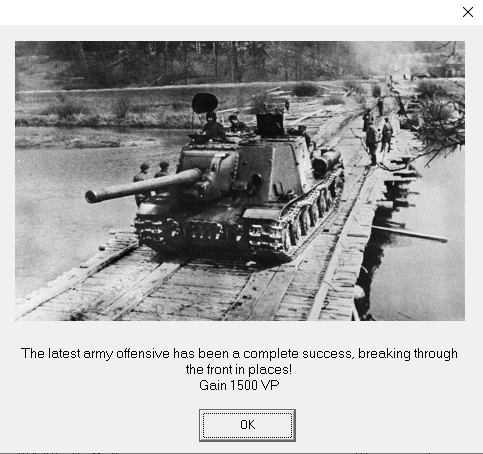
With the budget they so rudely stole from us (granted, with our consent), the army does its part in the land war.

We now have radar! We’ll get a certain number of sets each month, which will be installed on ships in approximate order of size.
That good news is somewhat tempered (by which I mean obliterated) by the greatest disaster of the war so far.
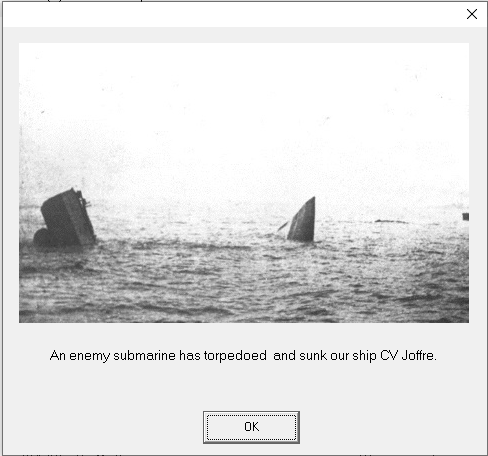
With the money the army returned after their successful offensive, I lay down Fratnernité, the second in the Liberté class of fleet carriers, as a replacement. (I suppose Egalité ought to have come next. Oops.)
September 1937
… starts with a carrier battle against the Germans, a fight we should probably win.
The weather is overcast, however, and we only have five and a half hours until dusk. We’ll see what comes of it.
4:18 p.m.
Scouts from Brest report a pair of German light cruisers 250 miles to the west. It’s much too far to get planes there before dusk, however, so the play here is to hover around Brest overnight, then see if we can’t tag them in the morning. (This is a carrier battle, so we get 1800 minutes—more than a full day—to get our strikes in the air.)
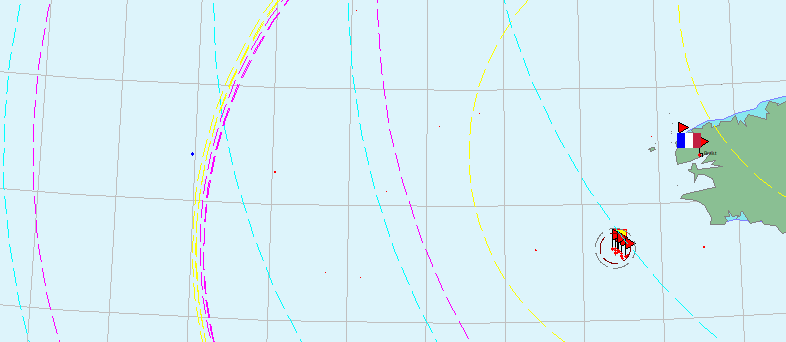
Note the blue dot well out to sea to the west.
3:37 a.m.
It was a good thought, but gale-force winds and drizzle will prevent us from getting planes airborne this morning. There’s still time for the weather to change, though.
September 1937, continued
The carrier battle was a draw, but news reaches French ears of strikes and anti-war demonstrations in Germany, which can only be good news for us.
The Americans contribute some, sinking the German cruiser Cöln in a battle we aren’t a party to.
Our battleships Lyon, Suffren, and Marengo now have radar, along with the carrier Bearn and a random destroyer.
October 1937
The light cruiser Linois embarks on a raid of Austrian coastal shipping, with a screen of four destroyers.
It’s a hectic day. Thanks to air reconnaissance, we know where the Austrian patrols are, and are able to dart in and knock out a pair of merchants before the patrols can react. They do, however, catch up to us on the way back, sinking the 1920-vintage destroyer Oriflamme.
November 1937
A relatively quiet month. Land-based aircraft from Brest have a chance at getting stuck in against a German cruiser squadron, but fail to find a target in the shortened day.
December 1937
We might have a chance at taking down a German cruiser. In the Mediterranean, we have rough parity in forces with the Germans—us, because we can’t move ships out of Europe, them because their ships don’t have the range. We’re twenty miles from fifty strike planes at our airbases in Durazzo and Valona, and our lone heavy cruiser Latoche-Treville is approximately a match for the German cruisers.
Unfortunately, the German cruiser escapes despite a number of successful air attacks by our land-based forces (for once). We do bag the accompanying German light cruiser, which is enough to make it a victory.
January 1938
The Austrians invade Tunisia, of all the indignities, and there’s nothing we can do about it because the whole fleet is bottled up in Europe.
The battle of the month is a large enemy coastal raid. Opposiing it are two older French battleships, Rouen and Nancy, our 30-knot ship Magenta, and one of our 26-knot 14″ battleships Ocean. The carriers are also on the field, but the battle kicks off just as twilight is approaching, so they won’t be much use to begin with. For the moment, they anchor behind the minefields at La Rochelle.
7:53 p.m.
Nancy, equipped with a radar set, announces an unknown contact at a range of five miles. Cautiously, the fleet turns that way.
7:58 p.m.
It turns out to be a French merchant plying the coastal trade.
8:52 p.m.
Continuing what has thus far been a tense night, the destroyer Arc reports sinking a submarine.
10:40 p.m.
Guns echo off the coast near La Rochelle, and Bearn‘s radar set reports a ghostly contact.
12:27 a.m.
Requin reports the radar contact this time, 30 miles southwest from La Rochelle.
12:46 a.m.
It’s an enemy destroyer. It gets off a spread of torpedoes, one of which sinks the old light cruiser Cosmao. Another hits Ocean, but her torpedo protection system absorbs the blow.
1:09 a.m.
The fleet reports radar contacts to the northeast, at least three or four.
1:15 a.m.
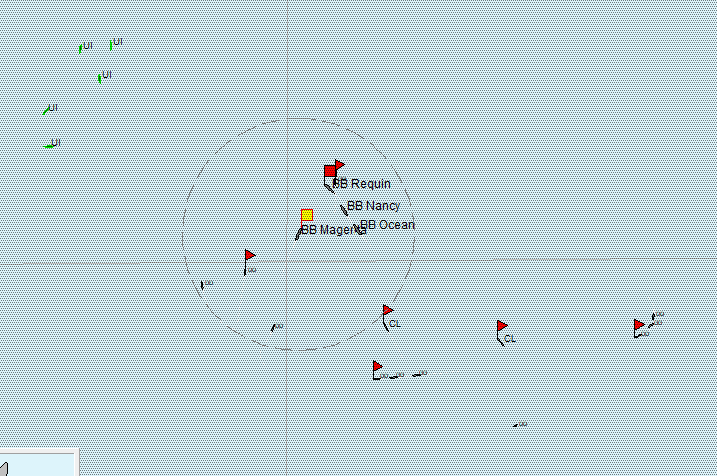
Make that five. I don’t think the Germans have radar yet, so I’m going to poke my nose in a bit and see what they have at sea.
1:36 a.m.
The answer is, as far as I can tell, a lot.
3:00 a.m.
I was inclined to leave the Germans alone, until they started driving hard for one of my precious carriers. A knife fight ensues.
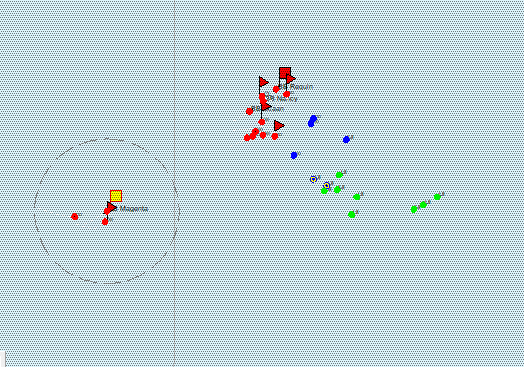
It ends with the fleets turning away from each other, avoiding torpedoes. Each of the fleets takes a torpedo hit or two. The French battle line drops to about 20 knots.
5:08 a.m.
That brief knife fight leads into another one, nearer the end of the night.

7:03 a.m.
Eager to perhaps pounce on any German stragglers, I keep the French battleships close at hand.
As dawn sweeps across the sea, it appears the Germans had the same idea: six dreadnought-type ships to our four, at close ranges where French gunnery and the French preference for heavy deck armor are rendered irrelevant by the sheer weight of broadside from the German ships.
It goes poorly.
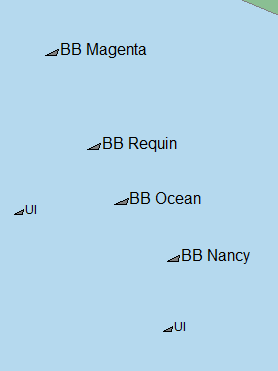
10:16 a.m.
A brief moment of hope in late morning, as sixty strike planes launch from various airbases along the Channel coast, gives way to final despair. Clouds roll in low over the sea, and though the boom of German guns still echoes along the coast near La Rochelle, the pilots can’t spot their targets to make attacks.
I probably ought to have run for it earlier, but got a bit too greedy in trying to press what I perceived as an advantage. Turned out that it was not an advantage at all.
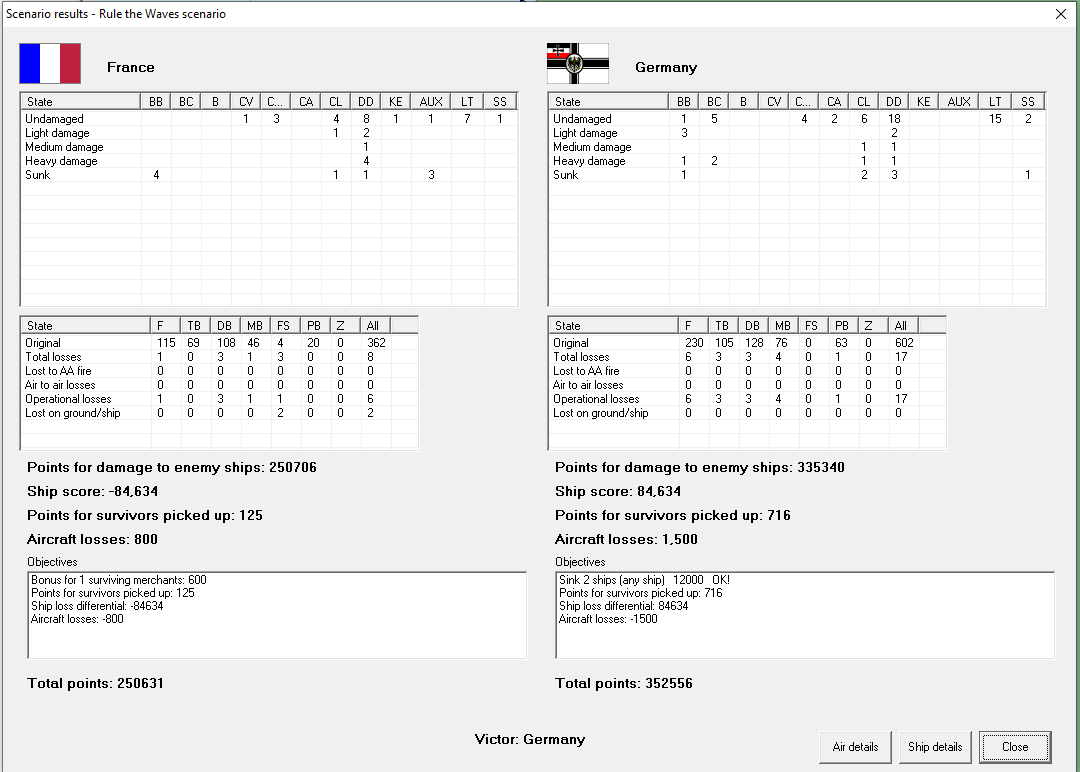
Sadly, this more or less erases our victory against Germany earlier in the war—we’re back to a deficit in dreadnought ships, and the war score is just about even. (We’re a few thousand points in the lead.)
February 1938
Austria attacks a convoy trying to resupply Tunisia. Despite a huge inferiority in forces, I think I want to play this one out—we have a large superiority in land-based air in this part of the theater, which might work out this time, and I want to do everything I can to support the ground forces in Tunisia.
And, thanks to a change made in a recent patch whereby the AI considers local air superiority in deciding whether to accept battle, Austria declines battle.
The next option: a fleet battle against Germany near Jutland, which I think I am going to decline. I’m a bit gun-shy, for one. For another, it’s much too close to Germany’s land-based air and a bit further from mine than I’d like.
The next one is a German coastal raid, similar to the one I just lost. I think I will play this one out, although I’m going to be extremely careful with the fleet. If the weather’s not fit for air attacks, I’ll just steam away from the coast.
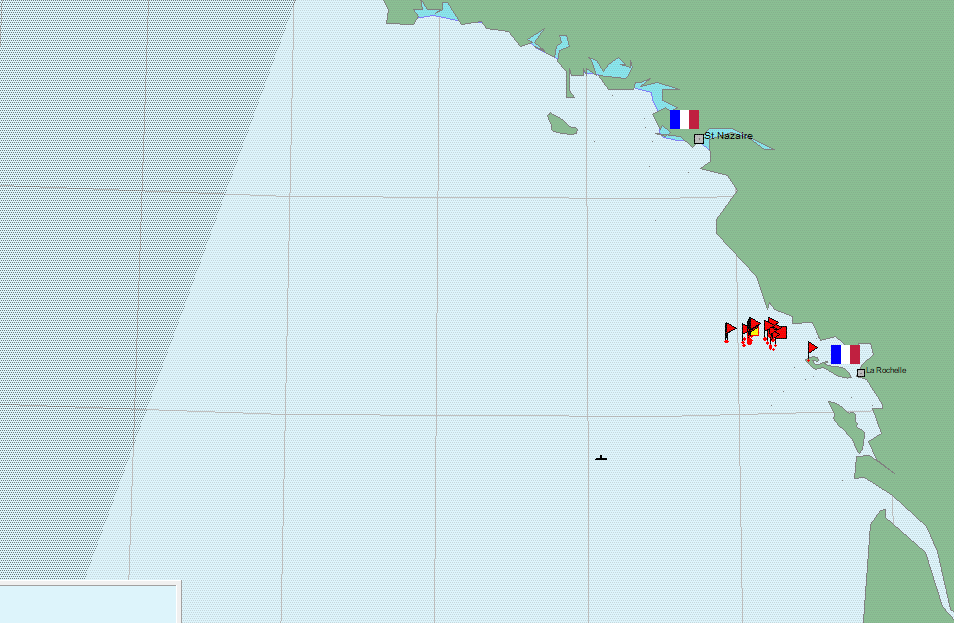
This one starts at twilight in the same region as the last one, and suggests I need an airbase at either St. Nazaire or La Rochelle. The plan is to steam south overnight, and find the Germans in the morning.
There’s a stiff breeze, but the weather is otherwise clear, which bodes well for getting some carrier-striking action in. The wind is out of the north, however, which will make it difficult for my carriers to make headway to the south when there are air operations going. They have to turn into the wind to launch and recover planes.
7:28 a.m.
Oops. It’s the dawn twilight, not the dusk twilight. Well, I’ll get the strike planes loaded up, and hopefully we’ll have some bombs on some German battleships to take revenge for our losses in the previous raid.
7:51 a.m.
Enemy floatplanes buzz overhead. At about the same time, spotting reports come in, putting the enemy about 90 miles to the northwest. This spotting report is only for a few battlecruisers and cruisers, likely a scouting force ahead of the main body. Not that I’m going to complain about sinking battlecruisers instead of battleships, if it comes to that.
I launch strikes from all three light carriers, a total of 42 planes. I’m reserving Bearn‘s Sunday punch, the largest of the bunch, for a few minutes, in case a better spotting report comes in.
7:59 a.m.
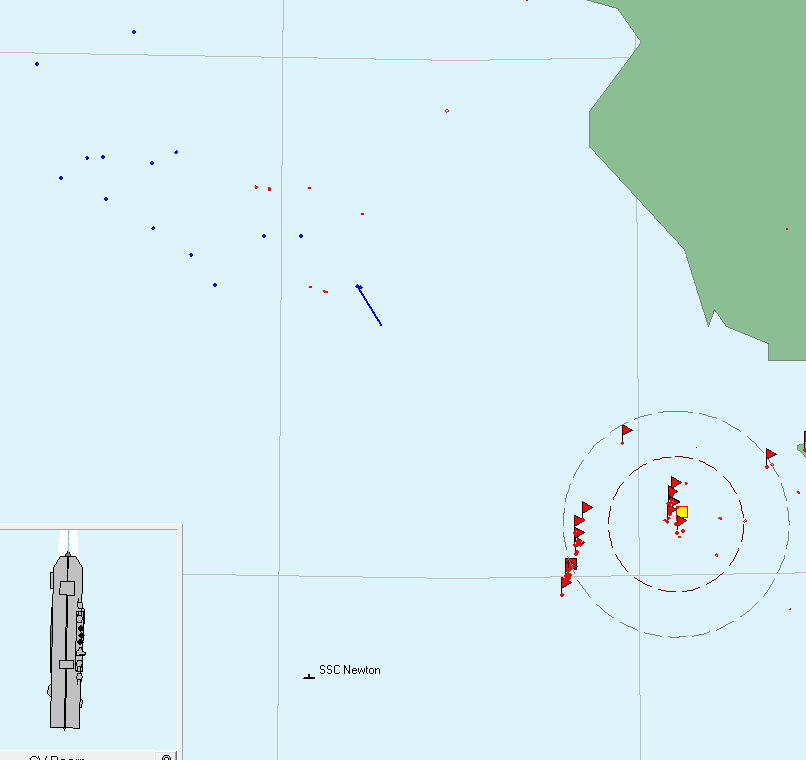
It does. This one says there are some light carriers at sea. That’s where Bearn‘s planes will go.
8:28 a.m.
The strikers are airborne and en route. Here’s hoping they shoot straight today.
8:51 a.m.
A little concerningly, the enemy is closer than I expected, only about 40 miles away.
8:56 a.m.
The bombs start to fall: a German cruiser takes two hits from our dive bombers’ 1000lb numbers, and a ship of unknown type takes three torpedo hits.
9:02 a.m.
Bearn‘s strike arrives, hitting a destroyer with two 1000lb bombs and a battleship with three, and getting some torpedoes off to boot.
9:04 a.m.
Five torpedoes find their mark, along with another bomb.
9:24 a.m.
The first strike is on its way back. In the meantime, seven German torpedo bombers make it through the French CAP, but withering fire from the French battleships drives them off. Only Rouen comes close to taking hits.
9:46 a.m.
The first wave starts to land. It may only be February, but there’s more than enough daylight to get a second wave up, and I think we have enough of a southward sprint to make it relatively safe even with the German fleet bearing down on us.
9:59 a.m.
The last of the strike planes unspools the arrestor cables as it sets down on deck, while land-based strikes from Brest and Cherbourg approach the enemy ships.
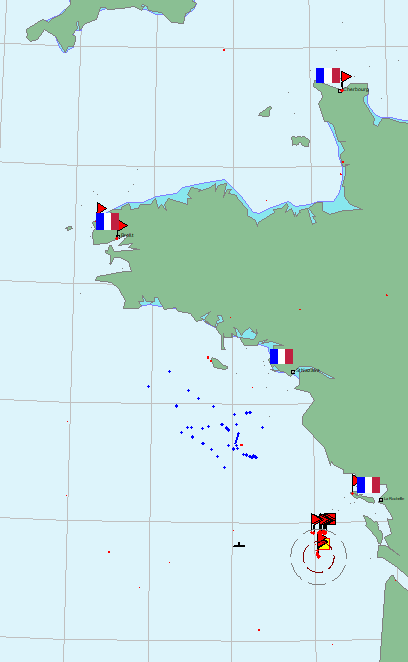
They’ve come from a long way off.
10:22 a.m.
While the carrier crews, having rearmed their planes with admirable alacrity, get the second wave of strikes spotted to the deck, land-based torpedo bombers take a crack at an enemy light carrier, hitting it once.
10:33 a.m.
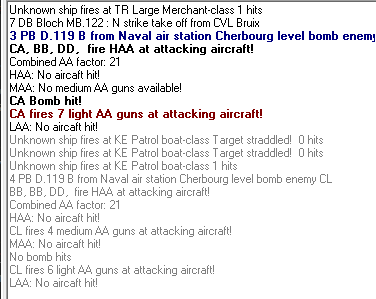
Level bombing rarely works against ships, but some flying boats out of Brest make it happen.
10:48 a.m.
The second wave of strikes is on its way up.
Our new Bloch dive bombers have very long range for the era, which is why I got this popup for planes out of Cherbourg.
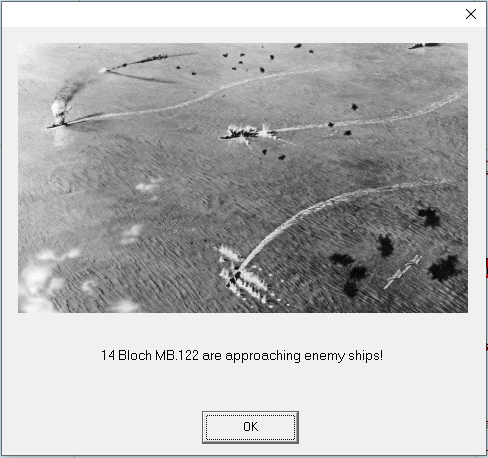
When our Liberté-class carriers enter service, hopefully we’ll see more of this sort of thing.
10:52 a.m.
The bombers report six hits on cruisers and six on carriers. Out of 14 bombers, that’s either spectacular accuracy or awful bomb damage assessment.
11:23 a.m.
The second strike from the carriers arrives, a bit less well-coordinated than the first wave. The torpedo bombers nevertheless acquit themselves well, scoring four hits on dreadnought-size ships and one on a cruiser.
11:55 a.m.
The dive bombers, a bit tardy, now arrive on the scene, planting four bombs onto cruisers and one on a carrier.
11:59 a.m.
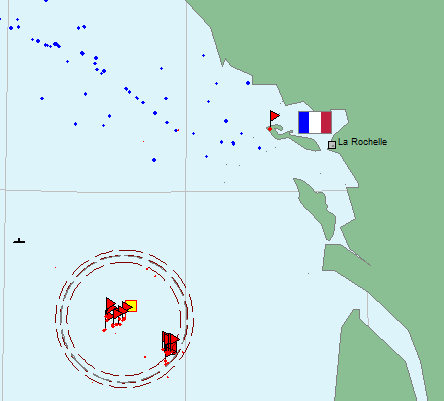
Spotting reports are now placing the enemy within the minefields at La Rochelle. As soon as we have strike planes to launch at them, I’m going to launch a third wave, which should just fit in before dusk.
12:25 p.m.
Dixmude and Arromanches, our elder light carriers, are a bit ahead of the game, and launch a strike a few minutes before Bruix and Bearn see their planes land.
12:34 p.m.
Bombers from Brest attack a German carrier heading northwest, away from the action, and score a hit or two. Perhaps they managed to sink her.
At the same time, German dive bombers approach Bearn, which is currently busily striking planes below to rearm them. Or, perhaps not—her air wing has taken heavy losses, and is down to only six effective bombers, thanks to an afternoon recon launch. Perhaps it’s time to let her pilots take a breather.
1:14 p.m.
After 45 minutes, I realize that the ‘Carrier Name has X aircraft torpedoes remaining!’ popup dialogs I saw when prepping the strikes were not advisories but exceptions. Correcting it by loading the torpedo bombers with standard bombs, I finally get the strikes moving. Because the enemy is so close, the strikes will still arrive in time to return before dusk.
1:54 p.m.
40 minutes later, the last wave of planes is airborne.
The battleships head northward, in hopes of perhaps catching a German straggler or two before nightfall.
2:23 p.m.
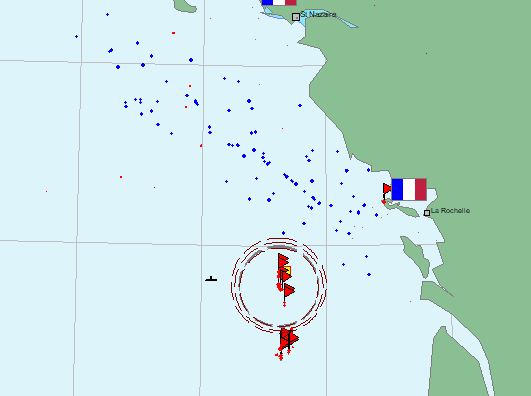
It might even pay off. The last wave spots enemies a mere 27 miles from our battle line, and goes in for the attack.
2:32 p.m.
A trio of Arromanches‘ dive bombers pull off a picture-perfect attack, rolling over one after the other, pulling into steep approaches, and planting three bombs in a row on an enemy battlecruiser.
2:36 p.m.
As the strike aircraft head back to their carriers, the light cruiser Voltaire, playing scout for the battleship line, spots an unidentified enemy ship.

2:46 p.m.
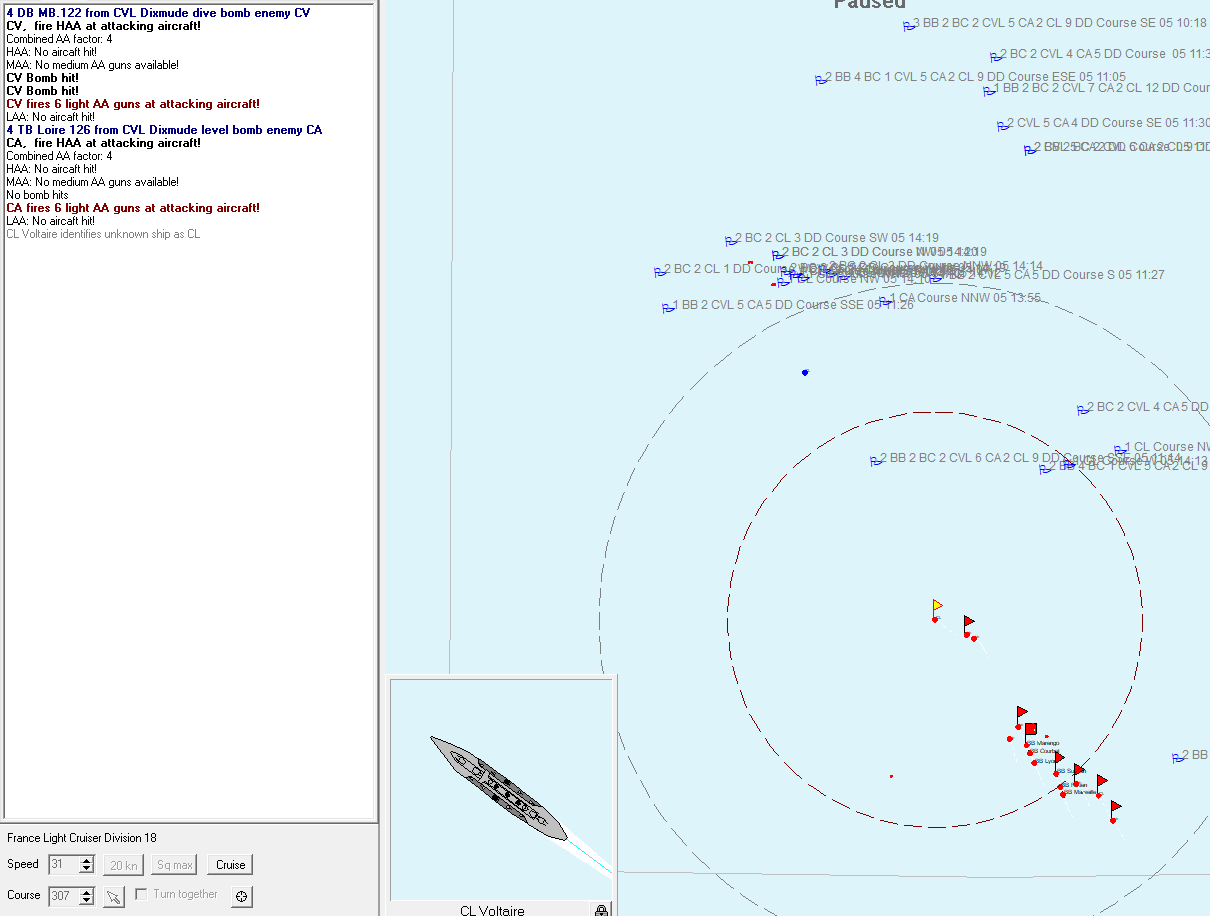
The greatest of prizes: a carrier, soon to be in range of battleship guns.
3:09 p.m.
Dive bombers from Brest attack a German light carrier, scoring a number of hits.
The carrier upon which our battleships are closing in begins to open the range. It makes sense that carrier would be faster.
3:20 p.m
Still, there are targets worth shooting at.
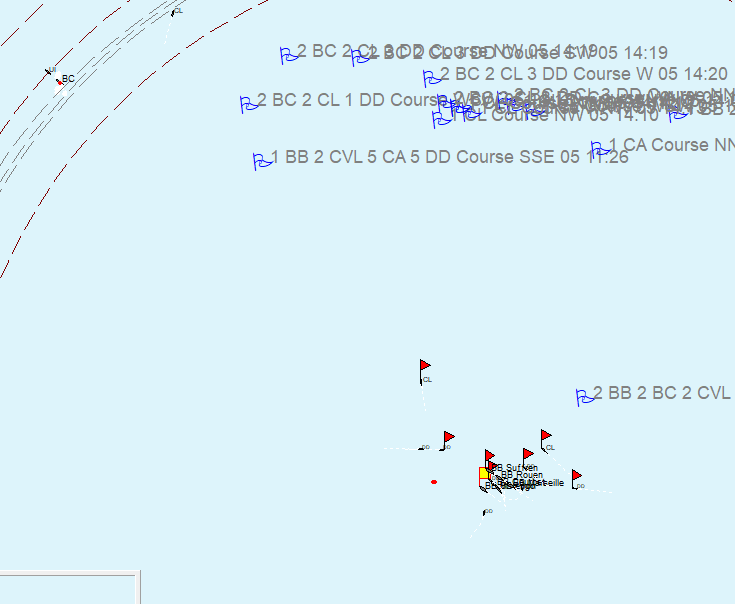
The gun action begins. Suffren lands a blow on one of two German battlecruisers at a range of more than 28,000 yards.
3:26 p.m.
The destroyer Pique identifies both of the German ships: a Derfflinger type, from 1917, and one of the modern Lützows, which would be a great feather in our cap.
3:38 p.m.
This is the first battle in which we truly see the benefit of the all-forward main armament. Our new-style battleships Marengo, Courbet, and Suffren are each bringing their full battery of eight guns to bear.
4:04 p.m.
Marengo is going to get the lion’s share of the credit for the Lützow. A long-range hit from her 16″ guns hits the German battlecruiser’s engine room. Steam boils up from her hull in a vast cloud.
4:26 p.m.
A flash fire in the Lützow‘s turret breaks her in two. Damage to the Derfflinger is beginning to tell, as well, as the hits from the French battle line, hungry for vengeance, begin to come faster.
5:01 p.m.
As twilight sweeps over the field of battle, the Derfflinger is a burning pyre, rocking in the waves, engines dead. The French fleet turns away from an incoming destroyer attack, but a moment too late—Marengo and Lyon take torpedo hits. Neither appear to be fatal, and with a victory assured, I can take the luxury of slowing down to limit flooding and turning for home.
5:48 p.m.
Nightfall. French destroyers circle the stricken Derfflinger, pouring torpedoes into her battered hull until she rolls over and sinks.
10:22 p.m.
I had intended that to be the end of this battle report, but radar yields an unexpected coda.
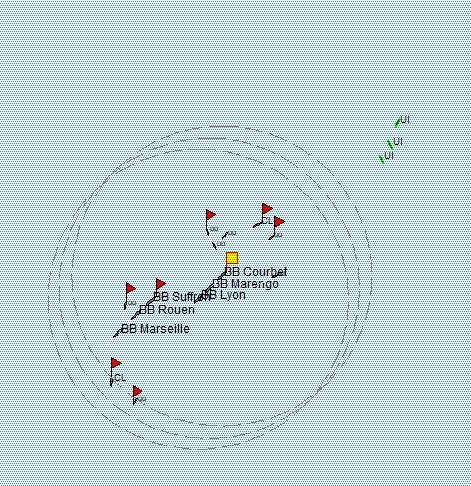
With the battle line a bit battered, I signal for the destroyers to have a go with torpedoes.
The Germans have the same idea, and in a wild nighttime battle, they get the better of us. Miraculously, even though Lyon and Rouen, older ships with poor torpedo protection already lightly damaged, take several hits each, both appear content to stay afloat.
There was a carrier with the Germans, but with our line slowed by damage, we don’t have much chance of catching it. We settle for beating the tar out of a destroyer.
12:39 a.m.
I had intended that to be the end of this battle report, but once again, radar intervenes.
A contact just south of the fleet turns out to be the German light carrier from earlier, damaged by bomb attacks earlier in the day. With the most heavily damaged battleships already on the way back to port, I’m left with four ships fit for action and capable of 23 knots. The carrier is faster, until the battleship shells find their marks.
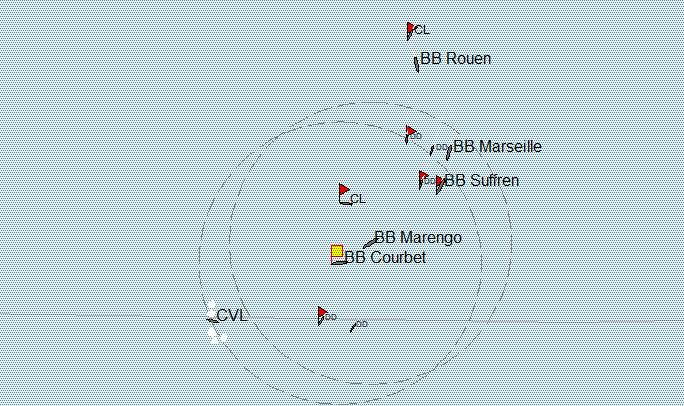
It is a deeply unfair fight.
Results
And a deeply unfair result, but in our favor, so I’m not going to complain. Three German dreadnoughts are on the bottom of the Bay of Biscay now: the battleship Hannover, and the battlecruisers Hindenburg and Graf Spee. Alongside them are the heavy cruser Prinz Heinrich and the light carriers Weser and Jade, plus a pair of destroyers. French losses amount to one patrol boat and four merchants, along with varying degrees of damage to the battleship fleet.
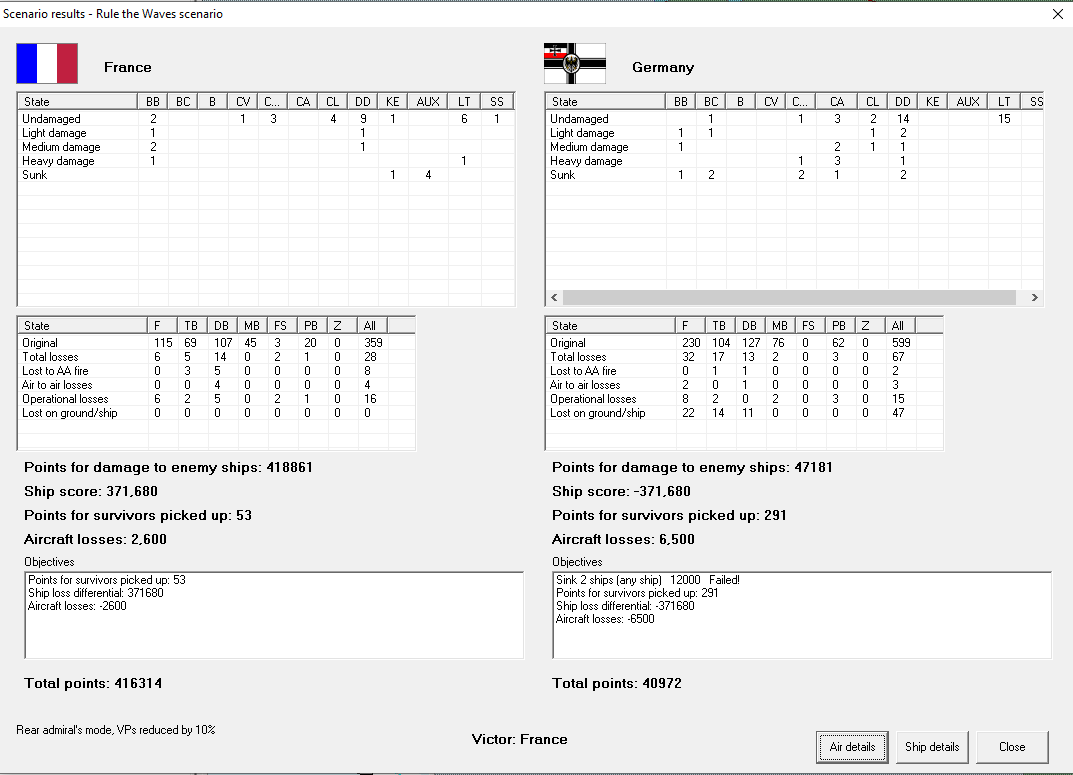
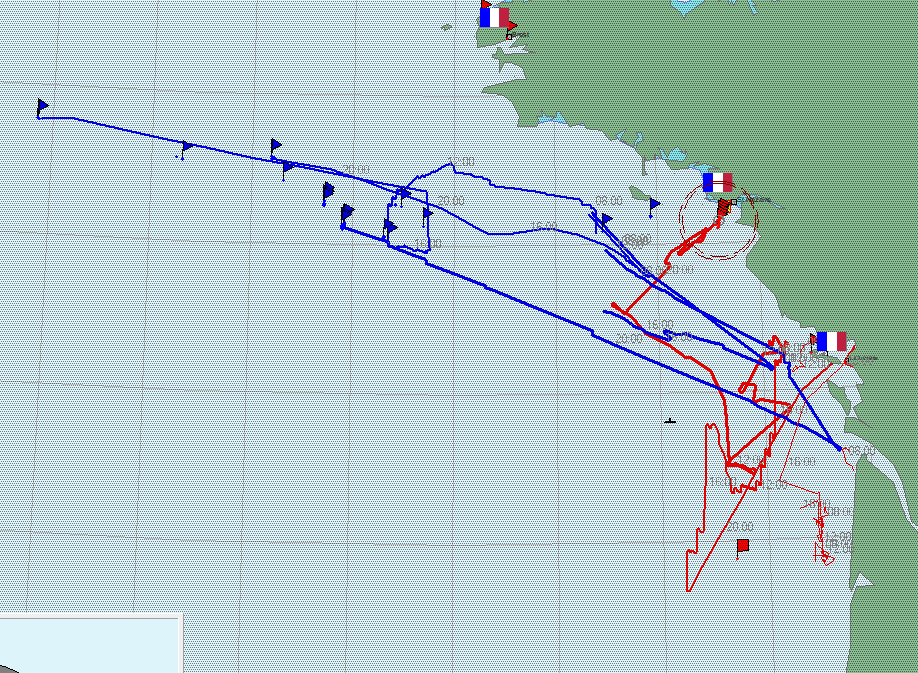
The map is a bit confused, but you can see the battlecruiser battle at the little spur in my main force’s line, where the blue line ends.
Further rumors of mutinies and strikes in Germany and Austria reach our ears.
Plans and Intentions
Germany is still blockading us, so there’s not much war planning to do beyond ‘hope for good carrier weather and sink more battleships’. Intelligence suggests we’re winning the battle of the home front. Unrest in France is low. Unrest in Germany and Austria is believed to be high. We’re ahead 63,603 to 41,969 in war score. An airbase is currently building at La Rochelle, to improve our land-based coverage of the central Bay of Biscay.
We do, however, have some construction choices to make soon. Currently in the shipyards are Solferino (finished in one month), a 30-knot, 14″-gun battleship; Liberté (five months) and Fraternité, 90-plane fleet carriers; and four modern 2000-ton destroyers (5-6 months).
That is to say, we’ll have two budget slots for capital ships in the near future. I plan on using one to build Egalité, completing the set. With the other slot, should we build another battleship, build another carrier, build heavy cruisers, build light forces, or build submarines?
The French are driving Russian license-built ISUs? I guess that’s better than the Char B1s, hence victory in Alsace-Lorraine.
Pity about losing a BB squadron, but we more than made up for it in the second big fleet action. I’d prefer building more of those 90 plane heavy carriers.